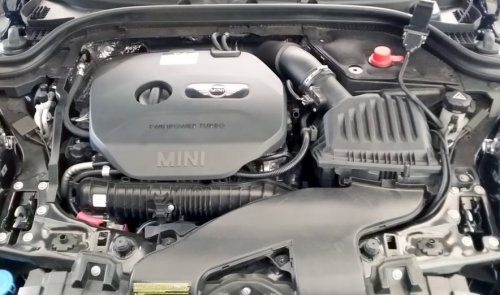BMW B48 Four Cylinder Turbocharged Engines

B38 in a 225i Active Touring.
Chronology
The B48 is part of BMW's modular engine series of three, four and six cylinder units with common technologies and production tooling. Four cylinders used to be the babies of the range but with the dawn of the excellent three cylinder B38 this is no longer the case, the fours have moved up market.
The B48 was launched in 2014 for MINI and 2015 for BMW. In BMW's cars it replaced the N20 2.0. It's More efficient than N13 / N18 "Prince" engine which was used in MINIs and some smaller BMWs.
It's amazing to think the MINI and 330i will now share the same basic engine!

B48 in transverse configuration with intercooler.
Design
These engines use the technologies you'd expect in the current modular engine family. They have all alloy construction, Valvetronic, direct fuel injection and dual VANOS.
To ensure smoothness twin balancer shafts are fitted, the three cylinder B38 uses only one. The older N20 integrated balancers into the oil pump drive, the more direct system here may make the B48 smoother. There are two water pumps, one mechanical and one electric.
The turbo is a twin scroll unit, this wasn't possible on the B38 as it had an uneven number of cylinders. It has it's own dedicated coolant pump. The intake manifold also serves as a water / air intercooler for rear wheel drive cars, front wheel drive installations use a normal intercooler.
As seem common practice with modern BMW engines the timing chain is at the back of the engine, let's hope it's more reliable than the N47s. The oil pump is chain driven and also at the back of the engine. It has it's own chain tensioner and guides. The high pressure fuel pump is driven from the camshaft and not by the timing chain as in some previous models.
There are four acoustic covers in addition to the top cover! So it should be very quiet. They also provide thermal insulation which helps the engine warm up faster and stay warm when turned off.
Power differences between units of the same capacity are down to the camshafts, programming and turbo boost. In addition the more powerful units have a higher compression ratio.
On some models there is an over boost facility, this lets the engine generate as much as 10% more torque in bursts of up to 20 seconds. Handy when overtaking.
Variants
| Code | Size | Power bhp@rpm |
Torque lb/ft@rpm |
BHP/ litre |
Torque/ litre |
Made | Bore x Stroke |
Timing | Weight (kg) |
VANOS | Used in |
| B48 | 2.0 | 189 @ 4700-6000 231 @ 5200-6000 228 @ 4750-6000 181 @ 4750-6000 249 @ 4750-6000 |
207 @ 1250-4800 236 @ 1250-4800 258 @ 1250-4500 214 @ 1250-4500 258 @ 1250-4500 |
94 115 114 90 124 |
103 119 129 107 129 |
2014 on | 82x94.6 | Chain | ? | Dual | Mini Cooper S Cooper JCW 225i Active Tourer 320i LCI 330i LCI |

B48 in a MINI Cooper.
Problems
As they're direct injection they may build up deposits on the intake valves which must be manually cleaned. Most modern engines suffer from this problem, not just BMWs.
Many owners will have these engines remapped for more power. That's OK so long as it's done properly on a rolling road and not taken too far. Avoid any cheap and nasty modifications.
Clean oil is vital to the life of a turbo engine. As these engines have extended oil change intervals it's vital the correct long life oil is used. It's expensive so beware of cheap substitutes. Now more than ever the service history matters when buying used cars. Personally I'd change the oil before the recommended interval as I think it's too long.